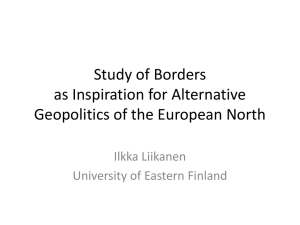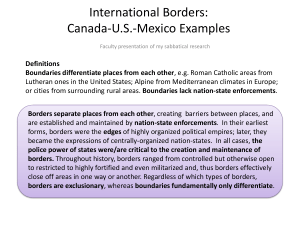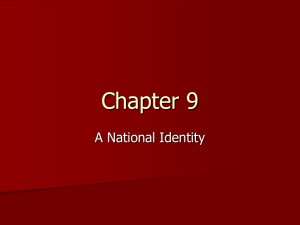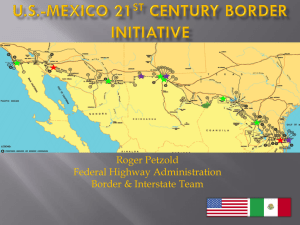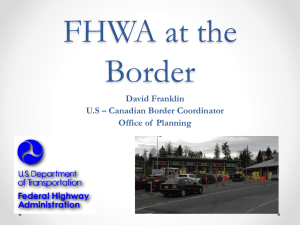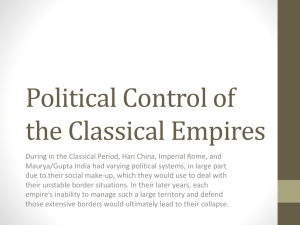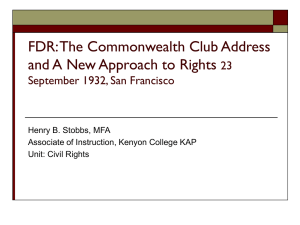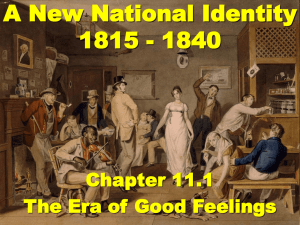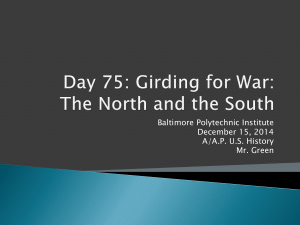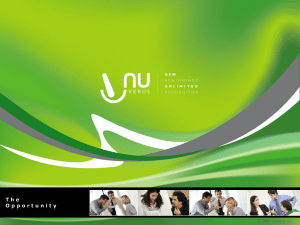to PDF-File
advertisement
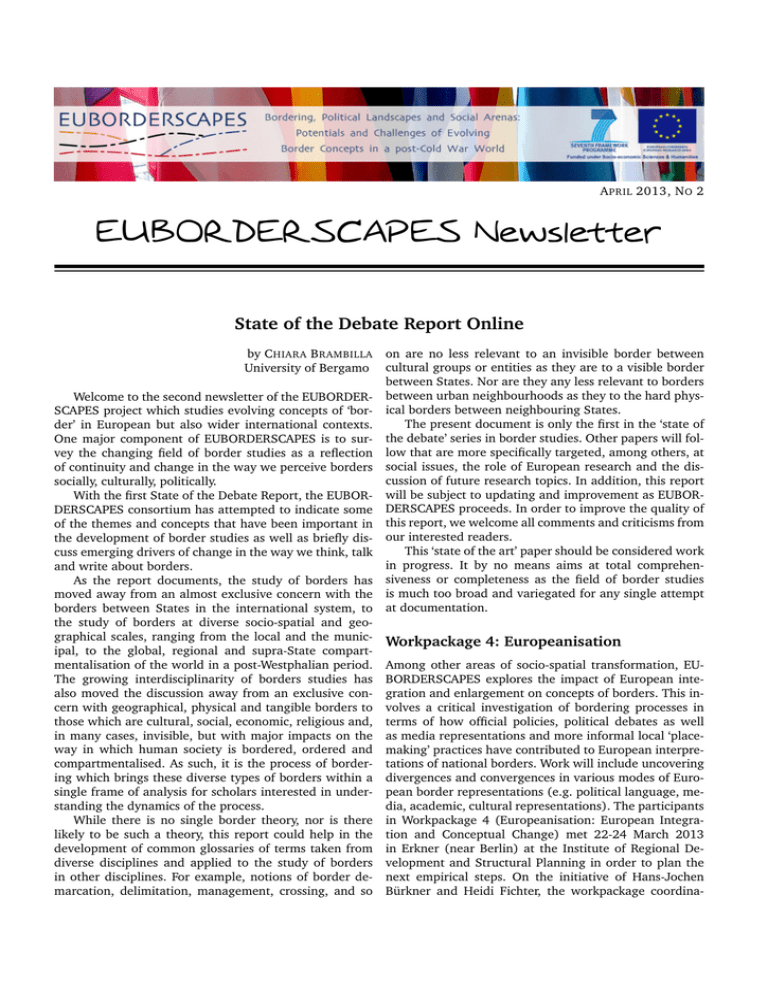
A PRIL 2013, N O 2 EUBORDERSCAPES Newsletter State of the Debate Report Online by C HIARA B RAMBILLA University of Bergamo Welcome to the second newsletter of the EUBORDERSCAPES project which studies evolving concepts of ‘border’ in European but also wider international contexts. One major component of EUBORDERSCAPES is to survey the changing field of border studies as a reflection of continuity and change in the way we perceive borders socially, culturally, politically. With the first State of the Debate Report, the EUBORDERSCAPES consortium has attempted to indicate some of the themes and concepts that have been important in the development of border studies as well as briefly discuss emerging drivers of change in the way we think, talk and write about borders. As the report documents, the study of borders has moved away from an almost exclusive concern with the borders between States in the international system, to the study of borders at diverse socio-spatial and geographical scales, ranging from the local and the municipal, to the global, regional and supra-State compartmentalisation of the world in a post-Westphalian period. The growing interdisciplinarity of borders studies has also moved the discussion away from an exclusive concern with geographical, physical and tangible borders to those which are cultural, social, economic, religious and, in many cases, invisible, but with major impacts on the way in which human society is bordered, ordered and compartmentalised. As such, it is the process of bordering which brings these diverse types of borders within a single frame of analysis for scholars interested in understanding the dynamics of the process. While there is no single border theory, nor is there likely to be such a theory, this report could help in the development of common glossaries of terms taken from diverse disciplines and applied to the study of borders in other disciplines. For example, notions of border demarcation, delimitation, management, crossing, and so on are no less relevant to an invisible border between cultural groups or entities as they are to a visible border between States. Nor are they any less relevant to borders between urban neighbourhoods as they to the hard physical borders between neighbouring States. The present document is only the first in the ‘state of the debate’ series in border studies. Other papers will follow that are more specifically targeted, among others, at social issues, the role of European research and the discussion of future research topics. In addition, this report will be subject to updating and improvement as EUBORDERSCAPES proceeds. In order to improve the quality of this report, we welcome all comments and criticisms from our interested readers. This ‘state of the art’ paper should be considered work in progress. It by no means aims at total comprehensiveness or completeness as the field of border studies is much too broad and variegated for any single attempt at documentation. Workpackage 4: Europeanisation Among other areas of socio-spatial transformation, EUBORDERSCAPES explores the impact of European integration and enlargement on concepts of borders. This involves a critical investigation of bordering processes in terms of how official policies, political debates as well as media representations and more informal local ‘placemaking’ practices have contributed to European interpretations of national borders. Work will include uncovering divergences and convergences in various modes of European border representations (e.g. political language, media, academic, cultural representations). The participants in Workpackage 4 (Europeanisation: European Integration and Conceptual Change) met 22-24 March 2013 in Erkner (near Berlin) at the Institute of Regional Development and Structural Planning in order to plan the next empirical steps. On the initiative of Hans-Jochen Bürkner and Heidi Fichter, the workpackage coordina- EUBORDERSCAPES Newsletter No 2 tors, the idea of ‘Europeanisation’ was subjected to criti- project of ‘self creation’ through interaction, communicacal scrutiny. tion, conflict and negotiation? It is likely that the emergence of common understandings of Europeanisation will involve tensions between all these meanings. It is likely that Europeanisation will be understood in terms of social progress at the same time that it involves different narrations of ‘us’ and ‘them’ and thus arbitrary processes of inclusion and exclusion. There is no question that these differentiated understandings of Europeanisation have affected how European borders have been narrated as well. EU Borders are at once integrators, guarantors of EU coherence and stability but also generators of injustice, exclusion and, in the opinion of many European anti-border activists (see, for example, the reference to FRONTEXIT below), human rights violations. Through its critical discussion of Europeanisation and borders, the WP 4 team will provide critical impetus to debates regarding the democratic governance of Europe’s borders as well as more generally reflect on the tensions inherent in the project to European Union. Workpackage 5: Relocating Borders Conference in Berlin: “Roundtable – Borders and Knowledge Production: a Comparative Perspective” Brainstorming session on Europeanisation While discussion brought out very different understandings and receptions of ‘Europeanisation’, there was consensus that this concept is a moving target – it changes as the EU itself is transformed through reform, crises and adaptation. A central debate that emerged during the WP 4 meeting regarded the extent to which Europeanisation implies convergence to a specific norm and/or divergence in terms of local forms of ‘European’ development. This question goes all the way down: is Europe, for example, an a priori given in cultural, historical and geographic terms or is it rather a non-finalisable During the Second EastBordNet Conference Relocating Borders: a comparative approach (Berlin, 11-13 January 2013), research approach in Workpackage 5 (PostColonial Bordering and Euro-African Borderscapes) of the EUBORDERSCAPES project was presented by Chiara Brambilla (University of Bergamo & participant in WP 5) during the roundtable ‘Borders and Knowledge Production: a Comparative Perspective’. Henk van Houtum (Nijmegen Centre for Border Research), lead participant in WP 5, also contributed to the discussion. The roundtable, jointly organised by EastBordNet and ABORNE, provided a forum of discussion for scholars belonging to networks – including institutions, centres, research programmes and so on – that have adopted borders and borderlands as core analytical frameworks in their scientific agendas. 1 The roundtable was comparative in nature, meaning not simply ways of establishing similarities and differences between phenomena observed across the globe, but also modes of comparing the conceptual, epistemological and empirical questions generated by studying borders in different regions. The emphasis on geographical (and thematic) diversity served to draw attention to the rootedness of such concerns in specific geo-historical settings and the scholarly knowledge produced on them (e.g. area studies). 1 Chair: Paolo Gaibazzi (Zentrum Moderner Orient, Berlin, Germany). Participants: Chiara Brambilla (University of Bergamo, Italy); Christine Thurlow Brenner (University of Massachusetts, USA); Emmanuel Brunet-Jailly (University of Victoria, Canada); Irasema Coronado (University of Texas El Paso, USA); Gregor Dobler (University of Freiburg, Germany); Hastings Donnan (Queen’s University, Northern Ireland); Sarah Green (University of Helsinki, Finland); Conrad Schetter (Bonn Asia Centre, University of Bonn); Henk van Houtum (Nijmegen Centre for Border Research, University Nijmegen, The Netherlands). EUBORDERSCAPES Newsletter m euborderscapes.eu B newsletter@euborderscapes.eu Page 2 EUBORDERSCAPES Newsletter No 2 These considerations on the relation between border studies and area studies and the most recent evolutions of the conceptualisation of borders are relevant with specific reference also to the regional focus on EuroAfrican borderlands investigated in WP 5 of the EUBORDERSCAPES project. The worldwide growth of borderrelated scholarship has been influencing debates and research agendas in area studies focusing on Euro-African relational geographies. In particular, debates on EuroAfrican borderlands have been influenced by research on the Mexico-US border. Debates on Euro-African borderlands have been also affected by attempts to frame the Euro-African relationship in ways that reference symbolic dimensions of borders and bordering practices inherent to this colonial as well as post-colonial relationships emerging from the Latin American experience of Iberian conquest, enslavement and independence. At the same time, regional dynamics shape the research questions asked by border scholars and in the case of EuroAfrican borderlands one can’t help but adopt a genealogical viewpoint. The peculiar regional dynamics characterising Euro-African borderlands between colonialism and post-colonialism give border scholars a chance to broadening and deepening debate and research on the spacetime of borders. Historicising Euro-African borderlands would help us to move towards a novel border imaginary able to describe the shifting and crossing processing of bordering between Europe and Africa, thereby denying that Europe and Africa can be reduced to single bounded entities. Looking at Euro-African borderlands and their genealogy, in WP 5 we propose to use the lens of ‘(postcolonial) Euro-African borderscapes’. This brings us to specifically address another question posed by Paolo Gaibazzi (Zentrum Moderner Orient, Berlin), the chair of the roundtable, by reflecting on borders not only as empirical sites but also as conceptual spaces to think about social reality. Taking the borderscape as a methodological angle, it would be interesting to inquire into the EuroAfrican border nexus by adopting a multi-disciplinary approach, able to highlight borders as complex multidimensional entities. The borderscapes framework allows us to investigate these discursive premises using the relational geographies between EU(rope) and Africa as a critical backdrop in multiple ways. We can examine how the conceptual links between EU-internal, EU-external and non-European borders are embedded within knowledge and control regimes and the consequences of these. We can examine the postcolonial continuities and ruptures in the European displacement and migration machine, and we can examine the consequences of EU borderscaping for the societal transformations of EU(rope) and Africa, exploring the shifting borders of the EU ‘neighbourhood’, while considering the crucial role of growing transnational communities, multinational actors and hybrid Euro-African spaces within Europe, and mainly within European cityscapes and multiplying hybrid urban thresholds. This means to develop a focus on what we can call ‘transversal Euro-African borderscapes’ across and beyond the borders of European and African regions respectively. This means investigating at the same time Africa(s) in/of Europe and Europe(s) in/of Africa. As theoretical reflection and empirical work underway in WP 5 suggest, taking the (post- colonial) borderscape as methodological angle gives us a chance to critically rethink the conventional geopolitical imaginaries that inform area/border studies with reference to EuroAfrican borderlands and beyond. EUBORDERSCAPES Conference ‘Mapping Conceptual Change in Thinking European Borders’ in Bergamo (Italy), 2–3 July 2013 The EUBORDERSCAPES Workshop 3 will take place on 2–3 July 2013 in Bergamo (Italy), organised by Italian project partner University of Bergamo; Centro di Ricerca sulla Complessità (Ce.R.Co). Right after the Workshop on 3–5 July 2013, the University of Eastern Finland, in cooperation with the University of Bergamo, will organise the first general Conference ‘Mapping Conceptual Change in Thinking European Borders’ of the EUBORDERSCAPES project in Bergamo. This conference will be organised as a joint event in conjunction with the FP7 project EUBORDERREGIONS (see: http://www.euborderregions.eu). The Conference is intended to present on-going research activities within these two large-scale international projects to the EUBORDERSCAPES Newsletter m euborderscapes.eu B newsletter@euborderscapes.eu wider public and to make a constructive contribution to the debate within border studies opening up a dialogue with scholars external to the project who are contributing to pushing conceptual, methodological and empirical research on borders and border crossings forward. However, the Conference does not aim to merely gather together researchers and academics who work on the issues of borders, but also social actors, policy-makers, practitioners, institutions and interested parties that are directly (and daily) involved in borders issues, implementing projects and solving problems, providing therefore a broad and multidisciplinary discussion. This will be done in line with policy relevant aspects of the EUBORDERSCAPES and EUBORDERREGIONS projects that Page 3 EUBORDERSCAPES Newsletter No 2 involve different levels of political and economic agency A Summer School will be organised in conjunction and a variety of social spheres. Keynote Speakers: Prof. with the Conference. Elena dell’Agnese (University of Milano-Bicocca, Italy) For further information: http://www.euborderscapes. and Prof. Prem Kumar Rajaram (Central European Uni- eu/fileadmin/user_upload/CallForPapers1_bergamo_ versity, Budapest, Hungary). 13.pdf. Report on the ‘Border Aesthetics’ conference, University of Tromsø, Tromsø 5–8 September 2012 by J OHAN S CHIMANSKI & S TEPHEN W OLFE Department of Culture and Literature, University of Tromsø The “Border Aesthetics” conference attracted 53 registered participants, including literary scholars, political geographers, historians, anthropologists, folklorists, linguists, media scholars, urban planners, architects, and students. Regional authors, performing artists, filmmakers, and artistic producers took part in a special panel. Several researchers from EU FP7 research projects EUBORDERSCAPES and EUBORDERREGIONS took part, as well as groups of researchers from the Finnish Academy research project Writing Cultures and Borders (WCTB) at the Karelian Institute, University of Eastern Finland, the Barents Institute in Kirkenes, and the Border Conditions group at Delft University of Technology. EUBORDERSCAPE researchers Stephen F. Wolfe and Henk van Houtum present on ‘The Waiting State: Kafka and Coetzee’s Imaginary Geographies of the B/ordering of the State’ EUBORDERSCAPES Newsletter m euborderscapes.eu B newsletter@euborderscapes.eu The aim of the conference was to investigate how changing perceptions of borders relate to shifting aesthetic practices, and as such the conference helps lay some of the grounds for the EUBORDERSCAPES workpackage 10, on ‘Border Crossings and Cultural Production’. The conference built on ongoing work at the University of Tromsø (the Border Poetics/Culture research group) and was the final conference of the Border Aesthetics research project (2010–2013). Paper topics addressed the negotiation of borders: in photography, political satire, feature films, artistic happenings, literary fiction, poetry, theatre performances, local communities, urban spaces, architecture, magazines, and life stories. Papers also addressed questions about the aesthetic dimensions of: the visibility/invisibility of borders, culture borders and diaspora, waiting at borders, the borders of the subject, ecological borders, the economic crisis and sovereignty. The conference featured three keynote lectures by Ulrike H. Meinhof, of the University of Southampton; by Fredrik Tygstrup of the University of Copenhagen. and by Debra A. Castillo of Cornell University. Four actors in the Barents Region aesthetic borderscape – Knut Erik Jensen (filmmaker), Liv Lundberg (poet and professor of Creative Writing, Tromsø), Liv-Hanne Haugen (dance artist) and Luba Kuzovnikova (artistic director, Pikene på broen, Kirkenes) – presented their work and shared with us their thoughts on cultural production in Northern borderlands in an inspiring panel. Dmitry Vilensky of art collective Chto delat? / What is to be done?, based in Petersburg, presented ongoing work in a “Songspiel” based on the Russian-Norwegian borderlands. The presentation was held at the Tromsø Gallery of Contemporary Art (Tromsø kunstforening). Their Museum Songspiel: The Netherlands 20XX was shown as an example of previous work, and a lively debate followed involving conference participants and members of the public. A special issue of conference papers, including two of the keynote lectures, is planned for the periodical Nordlit. The conference and an internal project workshop, which followed, were instrumental in developing work on a Page 4 EUBORDERSCAPES Newsletter No 2 book on Border Aesthetics. Collaboration with the Chto delat? / What is to be done ? art collective has resulted in a new issue in their series of newspapers, published in connection with the premiere of their Border Songspiel art video at the Barents Spektakel in February 2013. Financing was provided through the project by the KULVER (Assigning Cultural Values) research programme of the Research Council of Norway and the University of Tromsø, with additional funding from the University of Tromsø and from its Department of Culture and Literature. Transcending Borders through Artistic Expression: Chto Delat?, ‘A Border Musical’ and ‘Languages at/of the Border’ Ongoing cooperation with the St. Petersburg artists collective Chto delat? / What is to be done? involving several EUBORDERSCAPES participants has given input to their new art video and songspiel A Border Musical and resulted in the publication of a special issue of their political art theory newspaper. A Border Musi- cal is a songspiel with Russian and Norwegian actors addressing the topic of cross-border marriages. It was premièred at an open-air snow cinema screening during the yearly border cultural festival Barents Spektakel in Kirkenes, on 6 Febuary 2013. A trailer is available at http://vimeo.com/58962390. A still from the Chto delat?’s art video A Border Musical (48:30 min.) The Chto delat newspaper 11-35 is a special issue on ‘Languages at/of the Border’ produced in cooperation with the Border Aesthetics research project at the University of Tromsø, whose work provides part of the pretext for the EUBORDERSCAPES workpackage 10 on borders and cultural production. The newspaper, printed in the border town of Kirkenes, involves contributions by EUBORDERSCAPES researchers Holger Pötzsch, Henk van Houtum, Stephen Wolfe and Johan Schimanski, along with Jacques Rancière, Morten Strøknes, Mladen Dolar, Oxana Timofeeva, and Urban Wråkberg. It also includes the full script of A Border Musical by Tsaplya Olga Egorova and Dmitry Vilensky. The newspaper can be read online at http://bit.ly/12WCOFO. Cover of Chto delat newspaper ‘Languages at/of the Border’ EUBORDERSCAPES Newsletter m euborderscapes.eu B newsletter@euborderscapes.eu Page 5 S tep he n Wolfe a nd Henk Va n H outum Waiting at th e B o r d er with Fr an z K a f k a a nd J. M. Coe tze e – borderings Wai t i n g f o r t h e L a w a t t h e B or de r Waiting for the Barbarians before not yet before bordering, not yet the guard standing before the Law in Kafka’s parable, “You are insatiable.” The man from the country is waiting before the Law, and by internalizing and believing in the fantasy of the Law he has found a pseudo-home, an in-the-meantime home at the gate, yet his desire to unmask the void, to have access, to know the truth, to truly come home, is insatiable. This feeling of endlessness is also constructed by the gatekeeper, who warned him already at the there is no end indeed in searching for the truth, for after simulacrum-home. Hence, we necessarily live in a condition of not yet and never will be. We are unavoidably waiting before the Law. Wai ti n g f o r t h e B a r b a r i a n s Let us now turn to Coetzee’s novel Waiting for the Barbarians and see how the state of waiting before and at a border are used there. the language of the apartheid regime. Dealing with issues of torture, the novel was scrutinized by South African censors on its publication, but avoided being banned. The book is divided into six chapters spread over 170 pages, and the chapters are divided into shorter segments or scenes with allusions to Kalka’s The Trial, the novel that contains the short story “Waiting for the Law.” Many articles have been written on Waiting for the Barbarians since its publication, but we want to stress its depiction of the border and border guarding, the laws of Empire, and the complexity of identifying “barbarians.” At the beginning of Waiting for the Barbarians, the Magistrate, who is the narrator, despairs when Colonel Joll’s prisoners are but a diversity of Others. Colonel Joll, who is commander of the Third Bureau protecting the town, is ignorant of the frontier novel, what is foreign is always relative to the inside, the domestic, the familiar. The Third Bureau of the Civil Guard, who have come to assess the Magistrate and the frontier community, are “guardians of the state” and are part of the technical machinery of the Law and civil society. They enunciate who are Other according to the Law and have come to see for themselves how the laws of the Empire are enacted by the Magistrate. The creation of the other is crucial not only for creating images of the outsider, but also equally essential for constructing the insider: a white European male, the Magistrate and the colonel. Kafka’s and Coetzee’s texts both begin with a prohibition: an act of forbidding action or of forbidding a person to act by command or decree. The Magistrate will no longer be allowed to perform his role in the community. He is discredited by not knowing the law, but he is also guilty of ignoring the Law. The countryman and the Magistrate are not allowed entrance, in any case, not yet. Unable to cross the threshold, the men stay and wait. And by so doing they are inside the Law without knowing it. Let us see now how this is relevant to Coetzee’s novel. unyieldingness to the Empire and its policies. The acts committed in his jurisdiction in the name of Empire and necessity are acts that rob him of his individual authority and from which he seeks to distance himself. But he cannot distance himself from the torture, rape, and “the dark chamber” Joll uses to torture his victims. The Magistrate becomes increasingly connected with a “barbarian girl” whom Joll tortures: identifying with her becomes an escape from his colonial identity while at the same time also symbolizing the conquered land he imagines he can also heal. The girl’s body has traces of the border written on it. He The question of the torture of the girl, her father, and the young boy is impossible to evade in any meaningful discussion of the novel. Coetzee says that the novel is about “the impact of the torture chamber on the life of a man of conscience”: the Magistrate novelist’s imagination: “[T]he novelist is a person who, camped before a closed door, facing an insufferable ban, creates, in place of the scene he is forbidden to see, a representation of that scene, and a story of the actors in it and how they come to be there” Magistrate cannot imagine the girl’s suffering or Joll’s abuse of her. Not, at least, until he is tortured can he begin to understand and “identify” with the girl’s suffering and silence. The room is a border where the victim is held in isolation, waiting. Stephen Wolfe and Henk Van Houtum Waiting at the Border with Franz Kafka and J.M. Coetzee Although the b/order is an imagined-and-lived reality, that does not stop the desire for the true Self. The true b/order has no end, for realizations of wholeness never align with the fantasy perfectly. The perfect identity is always there, beyond the threshold, beyond the gates of the Law. The identity is the desire of a self or an order that is an unattainable Other. The emptiness of the Law produces a contingent reality and the contingent rituals of truth-keeping of those who wish to maintain the constructed b/ body knows Wa i t i n g p ro c e s s e s a t t h e bo r de r and thei r s i gn i f ic an c e must be Stephen Wolfe is Associate Professor of English Literature, University of Tromsø. In 2007 he and Johan Schimanski published the article collection Border Poetics De-limited. He is co-organizer of the Border Aesthetics research group. Research interests: Trans-atlantic literatures, captivity narratives, postcolonialism, migration. Henk van Houtum is Associate Professor of Geopolitics and Political Geography, Radboud University Nijmegen. He is head of the Nijmegen Centre for Border Research. Research Interests: borders, migration, home, national identity, soccer and identity. EUBORDERSCAPES Newsletter No 2 Call for Papers: ABS 1st World Conference 9–13 June 2014, Joensuu, Finland – St Petersburg, Russia The Association for Borderlands Studies (ABS) invites proposals for individual papers and posters as well as complete panels and roundtables related to multidisciplinary study of borders, border areas and crossborder interaction. Contributions from all world regions are encouraged. The organising theme for the 2014 World Conference is ‘Post-Cold War Borders: Global Trends and Regional Responses’. Since the end of the Cold War era, state borders have increasingly been understood as multifaceted social institutions rather than solely as formal political markers of sovereignty. The changing significance of borders has been partly interpreted as a reflection of global ‘debordering’, and of optimistic scenarios of globalisation and international cooperation. However, such notions of ‘de-bordering’ have been challenged by or even succumbed to the reality of ethnic and cultural tensions and increasing complexity and instability in the world system. It is time to ask how often contradictory global tendencies are reflected on the ground. We can recognise global megatrends that are changing the nature of borders but also regional and local processes of border-making and border negotiating. The unprecedented expansion and transformation of the global economy and the concurrent fluidity of people and goods within a context of increased securitisation, signifies fundamental societal challenges that directly relate to borders. On this view, borders help condition how societies and individuals shape their strategies and identities. At the same time, borders themselves can be seen as products of a social and political negotiation of space; they frame social and political action and are constructed through institutional and discursive practices at different levels and by different actors. Despite new border studies perspectives that favour a broad cultural, economic and complex governance view of borders and borderlands, a strict top-down international relations view of borders continue to dominate policymaking. This current era of heightened globalisation requires that we pay attention not only to the tendency of increased governance of borders and border regions, but also at the regional responses to such development. EUBORDERSCAPES Newsletter m euborderscapes.eu B newsletter@euborderscapes.eu Through regional responses to globalisation, borders are reproduced, for example, in situations of conflict where historical memories are mobilised to support territorial claims, to address past injustices or to strengthen group identity – often by perpetuating negative stereotypes of the ‘other’. However through new institutional and discursive practices contested borders can also be transformed into symbols of co-operation and of common historical heritage The general theme encompasses a wide range of topics and approaches. Please consult the conference website for inspiration. We invite proposals that focus on empirical research and case studies, conceptual and theoretical issues, and/or policy relevant aspect of border studies alike. Confirmed Keynote Speakers: • Prof. Oscar J. Martinez, University of Arizona • Prof. Paul Nugent, University of Edinburgh • Prof. Anne-Laure Amilhat-Szary, Université JosephFourier/CNRS-PACTE You can download the following forms: Proposal for an Individual Paper Proposal for a Panel Proposal for a Poster Instructions for submitting a proposal Submission deadline for complete panels or roundtables: 31 October 2013. Submission deadline for individual papers or posters: 30 November 2013. Please send your proposal to abs2014.secretariat@uef.fi The Association for Borderlands Studies 2014 World Conference is organized by the VERA Centre for Russian and Border Studies at the University of Eastern Finland in cooperation with the Centre for Independent Social Research and the European University at St Petersburg. The organisers wish to thank ABORNE – The African Borderlands Research Network and the Finnish Association for Russian and East European Studies for their financial and scientific contribution. Page 9 EUBORDERSCAPES Newsletter No 2 New publications from EUBORDERSCAPES team members articles on border narratives, an interview with Stephen Wolfe on border studies and aesthetics, and a review article by fellow EUBORDERSCAPES researcher Holger Pötzsch on borders in a North-Norwegian film classic (’Aspects of Liminality in Knut Erik Jensen’s Stella Polaris’). The whole issue can be read here: http://www. folklore.ee/folklore/vol52/. Project researcher Johan Schimanski at the University of Tromsø has contributed a chapter to a new book on borders in South African and Scandinavian literature, Crossing Borders, Dissolving Boundaries (Amsterdam: Rodopi, 2013), edited by Hein Viljoen of the Grensprojek at Northwest University Potchefstroom. Schimanski’s chapter, ‘Pronouncing it the Porder: The Ascription of Aesthetic Values to External and Internal National Borders in Frank A. Jenssen, The Salt Bin’, examines borders and border concepts in a novel about the indigenous Sámi people of the Tysfjord border region between Norway and Sweden. Other contributions to the book addressing geographical borders include one by Anne Heith on biopolitical borderings and exclusion on the Swedish-Finnish border. Folklore: Electronic Journal of Folklore published a special issue (52/2012) on Borders and Life-Stories after the fifth Autumn Conference of the Centre of Excellence in Cultural Theory, ‘In, Out and In-Between: Dynamics of Cultural Borders’, University of Tallin, on 17–19 October. EUBORDERSCAPES researcher Stephen Wolfe from the University of Tromsø presented a keynote lecture at the conference, and the special issue includes, along with EUBORDERSCAPES Newsletter m euborderscapes.eu B newsletter@euborderscapes.eu The Israeli-Palestinian conflict is one of the most prominent issues in world politics today. Few other issues have dominated the world’s headlines and have attracted such attention from policy makers, the academic community, political analysts, and the world’s media. Joel Peters and David Newman have produced an edited volume that brings together contributors who are leading authorities in their field and have published extensively on the Israeli-Palestinian conflict/peace process. Many have played a leading role in various Track II initiatives accompanying the peace process. This Handbook provides a comprehensive and accessible overview of the most contentious and protracted political issue in the Middle East. The editors have gathered together a range of the top experts from Israel, Palestine, Europe and North America to tackle a range of topics from historical background, through to peace efforts, domestic politics, critical issues such as refugees and settler movements, and the role of outside players such as the Arab states, US and EU. Sections present the reader with the historical background to the conflict, an understanding of the complexity of the issues that need to be addressed in order to resolve the conflict, and a detailed analysis of the varied interests of the actors involved. Page 10 EUBORDERSCAPES Newsletter No 2 Borders as Controversy and an Issue of Human Rights: the FRONTEXIT Initiative Frontexit is an international campaign for the de• transparency surrounding the mandates, responsifense of migrants’ human rights at the external borders bilities and actions of Frontex; of the European Union. It is led by 21 associations, researchers and individuals from both North and South • the suspension of those activities of the agency of the Mediterranean (Belgium, Cameroon, France, Italy, identified as violating human rights; Mali, Morocco, Mauritania, international organisations, regional networks). • the cancellation of the ruling creating the FronFrontexit has a twofold objective: to inform a wide autex agency, if it is proven that the agency’s mandience about the impacts of Frontex operations in terms date is incompatible with the respect of fundamenof human rights, and to denounce these impacts to the tal rights. political representatives who are directly involved. More concretely, through actions of investigation, litigation, awareness-raising and advocacy, this campaign For more information see: http://www.frontexit. aims to obtain: org/en/ EUBORDERSCAPES Newsletter m euborderscapes.eu B newsletter@euborderscapes.eu Page 11
